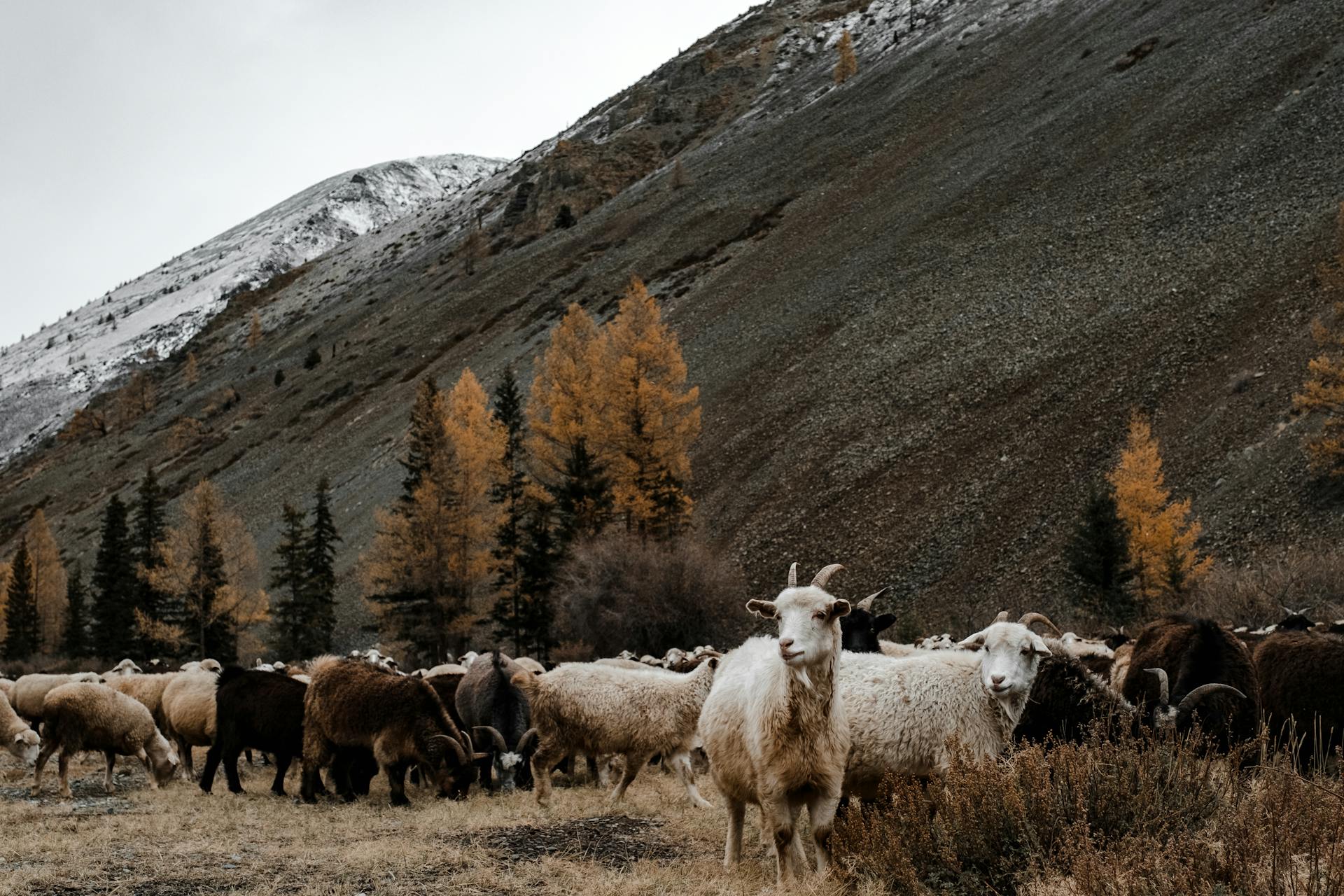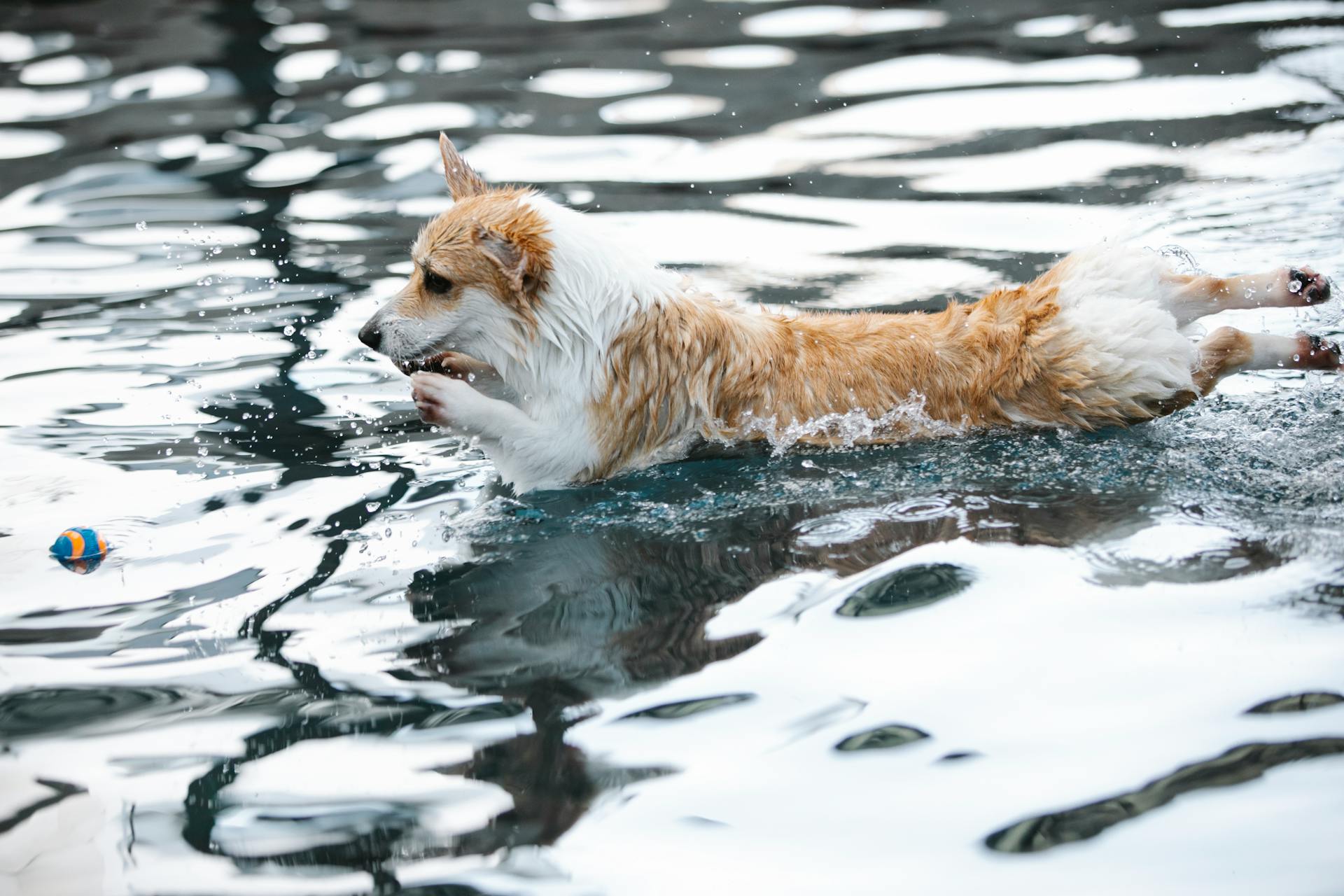
The Herding Instinct Test is a fascinating way to understand your dog's natural behavior and instincts. This test is based on the idea that herding breeds have an innate ability to gather and manage animals.
Herding breeds, such as Border Collies and Australian Shepherds, have been bred for centuries to herd livestock. They have a strong instinct to chase and gather animals.
The test typically involves observing your dog's behavior in a controlled environment, such as a fenced area or a room. The goal is to see how your dog reacts to moving objects or animals.
You might like: Australian Shepherd Herding Dog Breeds
What Is Herding Instinct?
Herding instinct is a natural ability that some dogs possess, allowing them to control and move livestock with ease. This instinct is often seen in breeds developed for herding, such as Border Collies and Australian Shepherds.
During a herding instinct test, a trainer assesses a dog's ability to show sustained interest in controlling livestock movement. This is one of the key criteria used to determine if a dog has a strong herding instinct.
A dog with a strong herding instinct will also be willing to take direction from their handler, which is known as trainability. This is an important aspect of herding, as the dog needs to be able to respond to commands and work together with their handler.
Stock sense is another crucial aspect of herding instinct, where the dog is able to read the behavior and movement of the livestock. This allows the dog to anticipate and respond to the needs of the stock.
The trainer will also look at the dog's instinctive herding style, learned work ethics, and biddability to determine the best short-term training plan. This helps to identify the dog's strengths and weaknesses, and to develop a training plan that is tailored to their needs.
A fresh viewpoint: How Do Dog Dna Tests Work
The Testing Process
The testing process for herding instinct is designed to assess a dog's natural ability to herd livestock. Tests are usually held in a smaller arena or round pen, using livestock that are accustomed to being worked by dogs.
The tester will take some time to describe what's going to happen and establish a trusting relationship with the dog. They'll often take the dog into the arena on a leash to help the dog understand that being around livestock is a kind of work, not play. The leash helps the dog realize that there's a pack leader, and that's why doing obedience at the beginning is crucial.
The tester will then remove the leash and create opportunities for the dog to succeed, which can help bring out the dog's hidden instinct. If the dog is worried or showing little interest, the tester may use various techniques to help the dog along, such as adding a trained dog to the scene.
What to Expect During an Instinct Test
During an instinct test, you can expect the tester to take some time to describe what's going to happen. The test is usually held in a smaller arena or round pen, using livestock that are accustomed to being worked by dogs.
The livestock should be non-confrontational and not too flighty or skittish. Most testers will take the dogs into the arena on their leash to create a trusting relationship between the tester and the dog, and to assess the dog's initial response to the livestock.
By asking for some obedience at the beginning, the dog will begin to realize that there is a pack leader, and that being around livestock is a kind of work; not play. If the dog is responding well, the tester will remove the leash and get into a position to create success for the dog.
Here are some behaviors you might see in a dog with good herding instincts:
- Drop their heads and approach the livestock with a crouched body.
- Strive to keep the group of animals together and to move them as one, including rounding up any strays.
- Naturally circle the animals to keep them together, showing some sense of how close the dog can get or how far away the dog needs to be to keep the livestock from spooking.
- Balance to the herding handler, meaning if the person is at 12 o'clock, the dog automatically moves to the 6 o'clock position.
A dog that passes a herding capability test will show sustained interest in herding livestock, and will move them in a controlled fashion from one end of the arena to the other. The dog must also exhibit a stop and a recall.
Titles

The first step to achieving a title in herding is to earn a herding instinct certificate, but be aware that this certificate isn't actually a title and won't appear on your dog's name.
Some breeders may still incorrectly include the "HIC" title after a dog's name, but this is a leftover from a previous rules change. This certificate simply requires your dog to show sustained interest in the stock without aggression.
Once your dog has earned its herding instinct certificate, it's eligible to enter the test levels. Traditional herding breed handlers often move straight into the Pre-Trial test (PT), but non-traditional breeds like our Finnish Lapphunds typically start with the Herding Test (HT).
The Herding Test is performed in a small yard, where your dog must demonstrate its ability to move and turn the stock around pylons in a figure 8 pattern, show a "stop", and call to the handler at the end of the run.

Here's a comparison of the two test levels:
The Pre-Trial test requires dogs to show three stops, including a controlled pause, one on course, and one while the handler opens the pen gate.
Preparing for the Test
To prepare for your dog's herding instinct test, it's a good idea if your dog knows a few obedience commands. A recall is also pretty important, as many dogs tend to forget their commands when they get excited around the stock.
Ideally, your dog should be able to lie down on command, which will help the tester stop and refocus your dog if they get too excited. This can make a big difference in the test.
There are no pre-requisites for an instinct test, so even if your dog doesn't know any obedience commands, they can still participate. However, having some basic obedience skills under their belt can make the test go more smoothly.
Understanding the Results
A herding instinct test is just that - a test, and the outcome may not be an accurate picture of what you have in a dog.
The test may be affected by many factors, including a dog's life experiences and age. Each dog matures differently, and often we won't see sustained interest until the dog is mature.
If a dog shows instinct, there's a good chance you'll be able to do some herding training with that dog. However, if a dog doesn't show instinct, it doesn't mean they don't have any instinct.
There are many things that can affect the test, such as a dog being taught not to chase, new surroundings, travel, or physical limitations.
A dog not passing the test doesn't mean they're not a good herding dog. It may just mean they need more time, experience, and training.
Here are some reasons why a dog may not pass the test:
- Fails to show sustained herding interest in livestock
- Leaves or attempts to leave the working area
- Makes little or no attempt to control the grouping and movement of the stock
- Shows aggression toward the livestock
- Cannot be tested off lead or with lead dragging in a fenced area
- Shows fear of the livestock
- Fails to demonstrate the required additional skills
Dogs not passing the test can be retested at another time.
What Comes Next
It's going to take more time in the round pen with goats to determine if Clover likes herding enough to continue.
Clover loved being around the goats, but she didn't like being told the rules and would sometimes disengage from the work or go lie down in the shade.
It's a delicate balance between not letting her practice bad behaviors and not discouraging her so much that she gives up.
Cathy had me come into the pen to see if my presence helped Clover be calmer and braver.
Clover doesn't LOVE herding enough to take corrections in stride yet, which means she needs more time and practice.
Frequently Asked Questions
How do I know if my dog is herding me?
If your dog is staring, chasing, and nipping at you, it may be exhibiting herding behavior. Check for other signs like circling, blocking, or trying to control your movements to confirm.
Featured Images: pexels.com


